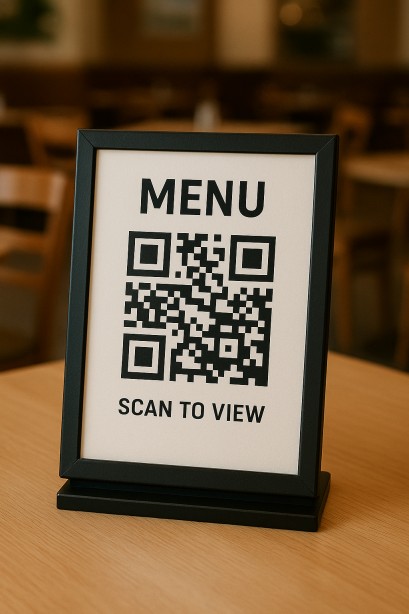
QR Codes Replace Barcodes: How Brands Like Tesco Are Upgrading Product Labels
Posted in :
Introduction: The Great Retail Label Revolution
After decades of dominance, traditional barcodes are facing their biggest challenger yet: QR codes. Leading retailers like Tesco, Walmart, and Carrefour are spearheading a quiet revolution that’s transforming product packaging from simple identification tools into interactive consumer experiences.
This shift isn’t just about upgrading technology—it’s about fundamentally reimagining how consumers interact with products, access information, and make purchasing decisions. From detailed ingredient sourcing to real-time inventory updates, QR codes are turning every product label into a gateway for enhanced customer engagement.
Let’s explore how major brands are executing this transformation and what it means for the future of retail.
The Limitations That Sparked Change
Traditional Barcode Constraints
Data Storage Limitations Traditional UPC barcodes can store only 12-15 digits—barely enough for basic product identification. This limitation forces retailers to maintain separate databases for detailed product information, creating disconnected customer experiences.
Static Information Challenge Once printed, barcodes cannot be updated. Price changes, product recalls, or new promotional information require entirely new packaging or additional labels, creating waste and increasing costs.
Consumer Engagement Gap Traditional barcodes serve retailers and supply chains but offer nothing to consumers. Shoppers seeking product information must rely on limited package text or search online manually.
The QR Code Advantage
Massive Data Capacity QR codes can store up to 4,296 alphanumeric characters—enough for websites, detailed product information, or complex data structures that transform how products communicate with consumers.
Dynamic Content Capability QR codes can link to websites where information updates in real-time, allowing brands to provide current pricing, availability, recalls, or promotional content without reprinting packaging.
Consumer-Centric Design Unlike barcodes designed for retail systems, QR codes empower consumers with instant access to detailed product information, reviews, usage instructions, and brand stories.
Tesco’s QR Code Leadership Initiative
The Digital Product Information Revolution
Comprehensive Product Transparency Tesco has begun implementing QR codes across thousands of products, providing customers with unprecedented access to:
- Complete ingredient sourcing and farm-to-shelf journey
- Nutritional information beyond basic label requirements
- Allergen warnings and dietary suitability indicators
- Environmental impact and sustainability metrics
Real-Time Inventory Integration Tesco’s QR codes connect to live inventory systems, allowing customers to:
- Check product availability at nearby stores
- Reserve items for pickup or delivery
- Receive notifications when out-of-stock items become available
- Compare prices across different package sizes automatically
Customer Experience Enhancement
Personalized Shopping Assistance Tesco’s QR implementation provides personalized experiences through:
- Tailored recipe suggestions based on dietary preferences
- Substitute product recommendations during shortages
- Loyalty program integration with automatic points tracking
- Shopping list integration and meal planning tools
Case Study: Tesco’s Fresh Produce Revolution Tesco piloted QR codes on fresh produce, allowing customers to trace vegetables from specific farms, view harvest dates, and access optimal storage and preparation tips.
Results:
- 67% increase in customer engagement with product information
- 34% reduction in produce waste through better storage education
- 45% improvement in customer satisfaction with product transparency
- 23% increase in repeat purchases of QR-enabled products
Global Retail Transformation Examples
Walmart’s Smart Shelf Initiative
Comprehensive Product Ecosystem Walmart’s QR code rollout across 4,700+ US stores includes:
- Integration with Walmart+ membership benefits
- Price comparison tools and savings calculators
- Product review aggregation from verified purchasers
- Cross-selling recommendations based on purchase history
Supply Chain Transparency Walmart uses QR codes to provide supply chain visibility:
- Supplier information and certification status
- Transportation carbon footprint data
- Fair trade and ethical sourcing verification
- Product recall history and safety information
Impact Metrics:
- 89% customer approval rating for QR product information access
- 52% increase in private label product sales through enhanced transparency
- 78% reduction in customer service inquiries about product details
- $127 million annual savings from reduced packaging and printing costs
Carrefour’s European QR Network
Multi-Country Implementation Carrefour has deployed QR codes across 12,000+ stores in 30 countries, providing:
- Localized product information in native languages
- Regional pricing and availability data
- Country-specific regulatory and certification information
- Cultural adaptation of recipe suggestions and usage tips
Sustainability Focus Carrefour’s QR codes emphasize environmental responsibility:
- Carbon footprint calculations for individual products
- Packaging recyclability instructions by region
- Sustainable alternative product suggestions
- Environmental impact comparisons between similar products
Performance Results:
- 43% increase in sustainable product sales
- 61% improvement in customer environmental awareness
- 29% reduction in packaging waste through digital information delivery
- 156% growth in mobile app engagement following QR integration
Amazon Fresh’s Integrated Experience
Seamless Online-Offline Integration Amazon Fresh stores use QR codes to bridge physical and digital shopping:
- Instant addition to Amazon cart for later online ordering
- Alexa integration for voice-activated product information
- Prime membership benefits and exclusive pricing access
- Automatic reorder scheduling for frequently purchased items
Advanced Analytics Integration Amazon leverages QR scan data for:
- Personalized product recommendations across all Amazon platforms
- Inventory forecasting and demand prediction
- Customer behavior analysis for store layout optimization
- Dynamic pricing based on real-time demand and competition
Industry-Specific Implementation Strategies
Food and Beverage Sector
Enhanced Food Safety Food brands use QR codes for comprehensive safety information:
- Batch tracking and expiration date verification
- Allergen warnings and cross-contamination alerts
- Storage temperature and handling recommendations
- Recall notification systems with automated alerts
Nutritional Transparency Advanced nutritional information through QR codes includes:
- Detailed macro and micronutrient breakdowns
- Dietary restriction compatibility (keto, vegan, gluten-free)
- Ingredient sourcing and organic certification status
- Calorie counting and portion size guidance
Case Study: Nestlé’s Global QR Strategy Nestlé implemented QR codes on 15,000+ products worldwide, providing:
- Complete ingredient transparency and sourcing information
- Nutritional guidance tailored to different age groups
- Recipe suggestions and meal planning integration
- Brand story and sustainability commitment details
Results:
- 71% increase in consumer trust scores
- 38% improvement in brand loyalty metrics
- 54% reduction in customer service inquiries about ingredients
- $89 million additional revenue from enhanced customer engagement
Fashion and Apparel
Sustainable Fashion Transparency Clothing brands use QR codes to address sustainability concerns:
- Complete supply chain transparency from fiber to finished product
- Labor condition certifications and fair trade verification
- Environmental impact assessments and carbon footprint data
- Care instructions optimized for garment longevity
Size and Fit Optimization Fashion retailers leverage QR codes for:
- Virtual try-on experiences and size recommendation tools
- Customer review aggregation for fit and quality insights
- Return and exchange policy information and process guidance
- Styling suggestions and outfit coordination ideas
Electronics and Technology
Technical Support Integration Electronics manufacturers use QR codes for:
- Instant access to product manuals and setup guides
- Warranty registration and tracking systems
- Technical support chat and video assistance
- Software update notifications and download links
Product Authentication QR codes help combat counterfeit electronics through:
- Blockchain-verified authenticity certificates
- Serial number verification and registration systems
- Authorized dealer and service center location tools
- Product history and previous ownership tracking
Technical Implementation Considerations
Infrastructure Requirements
Backend System Integration Successful QR code implementation requires robust infrastructure:
- Database Management: Scalable systems handling millions of product records
- Content Management: Dynamic content updating capabilities for real-time information
- Analytics Platform: Comprehensive tracking and reporting systems for QR interactions
- Security Framework: Protection against malicious attacks and data breaches
Mobile Optimization QR code experiences must be optimized for mobile devices:
- Fast Loading Times: Instant content delivery to prevent user abandonment
- Responsive Design: Optimal display across different screen sizes and orientations
- Offline Functionality: Basic information access even without internet connectivity
- Accessibility Features: Support for users with visual or motor impairments
Quality Assurance and Testing
Scanability Optimization Ensuring reliable QR code performance across various conditions:
- Size and Placement Testing: Optimal positioning for easy scanning
- Contrast and Color Analysis: Visibility under different lighting conditions
- Print Quality Verification: Consistency across different packaging materials
- Distance Testing: Functionality from various scanning distances
Cross-Platform Compatibility QR codes must work reliably across device ecosystems:
- iOS and Android Testing: Consistent performance across mobile platforms
- Camera App Integration: Compatibility with native device camera applications
- Third-Party App Support: Functionality with popular QR scanning applications
- Legacy Device Support: Accessibility for older smartphone models
Consumer Adoption and Behavior Changes
Demographics and Usage Patterns
Age-Based Adoption Rates QR code usage varies significantly across age groups:
- Gen Z (18-24): 89% regularly scan QR codes for product information
- Millennials (25-40): 76% use QR codes for price comparison and reviews
- Gen X (41-56): 61% scan QR codes primarily for basic product details
- Baby Boomers (57+): 43% adoption rate, primarily for health and safety information
Shopping Context Preferences Consumer QR scanning behavior depends on shopping environment:
- Grocery Stores: 72% scan for ingredient and nutritional information
- Electronics Retailers: 84% scan for technical specifications and reviews
- Fashion Stores: 68% scan for size guides and styling suggestions
- Pharmacies: 91% scan for medication information and interaction warnings
Behavioral Impact Analysis
Information-Seeking Behavior QR codes are changing how consumers research products:
- Pre-Purchase Research: 67% of consumers scan QR codes before making purchasing decisions
- Comparison Shopping: 54% use QR codes to compare products and prices in real-time
- Post-Purchase Engagement: 43% scan QR codes after purchase for usage tips and support
- Social Sharing: 38% share QR-accessed information on social media platforms
Trust and Transparency Expectations QR code availability influences consumer trust:
- Brand Transparency: 79% of consumers view QR code availability as a sign of brand transparency
- Information Authenticity: 85% trust QR-provided information more than traditional advertising
- Purchase Confidence: 62% report higher purchase confidence when QR codes provide detailed information
- Brand Loyalty: 71% show increased loyalty to brands offering comprehensive QR experiences
Implementation Strategy and Best Practices
Phased Rollout Approach
Phase 1: High-Impact Products Begin QR implementation with products offering maximum consumer value:
- Complex Products: Items requiring detailed explanation or instructions
- Health-Sensitive Items: Products with significant safety or dietary considerations
- Premium Products: High-value items where transparency adds perceived value
- Seasonal Items: Products benefiting from timely information updates
Phase 2: Category Expansion Gradually expand QR implementation across product categories:
- Customer Feedback Integration: Prioritize categories based on consumer demand
- Technical Optimization: Refine systems based on initial deployment learnings
- Staff Training: Ensure retail staff can assist customers with QR functionality
- Performance Monitoring: Track engagement metrics and optimize accordingly
Phase 3: Ecosystem Integration Develop comprehensive QR ecosystems connecting multiple touchpoints:
- Cross-Platform Integration: Connect QR experiences with mobile apps and websites
- Loyalty Program Integration: Link QR interactions with customer rewards systems
- Supply Chain Integration: Extend QR functionality to logistics and inventory management
- Partner Collaboration: Coordinate QR experiences with suppliers and vendors
Success Measurement Frameworks
Customer Engagement Metrics Track QR code performance through comprehensive analytics:
- Scan Rates: Percentage of customers engaging with QR codes
- Dwell Time: Duration spent viewing QR-accessed content
- Conversion Rates: Purchase completion following QR engagement
- Return Engagement: Repeat QR scanning behavior patterns
Business Impact Assessment Measure QR implementation success through business metrics:
- Sales Impact: Revenue changes attributed to QR code implementation
- Customer Satisfaction: Survey results and Net Promoter Score improvements
- Operational Efficiency: Cost savings from reduced customer service inquiries
- Brand Perception: Trust and transparency metrics improvement
Future Trends and Innovations
Advanced Integration Technologies
Augmented Reality Enhancement Next-generation QR codes will trigger sophisticated AR experiences:
- 3D Product Visualization: Virtual product demonstrations and try-before-buy experiences
- Interactive Instructions: Step-by-step visual guides for product assembly or usage
- Contextual Information Overlay: Real-time information display over physical products
- Social Shopping Features: Shared AR experiences for collaborative shopping decisions
AI-Powered Personalization Artificial intelligence will enhance QR code experiences:
- Behavioral Learning: Personalized content based on scanning history and preferences
- Predictive Recommendations: AI-suggested products and information based on consumer patterns
- Dynamic Content Optimization: Real-time content adaptation for maximum engagement
- Voice Integration: Voice-activated QR interactions for hands-free shopping experiences
Sustainability and Environmental Impact
Digital-First Information Strategy QR codes support environmental sustainability through:
- Reduced Packaging: Elimination of excessive printed information and instructions
- Dynamic Updates: Real-time information updates without reprinting materials
- Waste Reduction: Digital receipts and documentation through QR code access
- Carbon Footprint Transparency: Environmental impact information encouraging sustainable choices
Circular Economy Integration QR codes enable circular economy principles:
- Product Lifecycle Tracking: Complete product journey from manufacturing to disposal
- Recycling Instructions: Detailed guidance for proper product disposal and recycling
- Repair and Maintenance: Access to repair guides and spare part information
- Second-Hand Market Integration: Facilitating product resale and reuse opportunities
Getting Started with QR Code Product Labels
Planning and Strategy Development
Needs Assessment Organizations should evaluate QR implementation requirements:
- Customer Information Needs: Identify gaps in current product information delivery
- Technical Infrastructure: Assess existing systems’ capability to support QR integration
- Resource Allocation: Determine budget and staffing requirements for implementation
- Competitive Analysis: Understand industry QR adoption trends and best practices
Content Strategy Development Create comprehensive content strategies for QR experiences:
- Information Hierarchy: Prioritize most valuable information for consumer access
- Content Management: Establish processes for regular content updates and maintenance
- Multi-Channel Integration: Ensure consistency across QR and other communication channels
- Localization Requirements: Adapt content for different markets and languages
Implementation Support and Tools
QR Code Generation Requirements Successful product label QR implementation requires:
- High-Quality Generation: Professional-grade QR codes optimized for print applications
- Batch Processing: Capability to generate thousands of codes efficiently
- Quality Assurance: Testing and validation tools ensuring scanability across conditions
- Integration Support: Compatibility with existing packaging and design systems
For organizations beginning their QR transformation journey, QRCodeMyURL.com provides reliable, professional-grade QR code generation without the complexity of enterprise solutions:
- Print-Optimized Quality: High-resolution codes suitable for product packaging
- No Volume Limitations: Generate codes for small pilot projects or large-scale implementations
- Multiple Format Support: URLs, product information, and various content types
- Instant Generation: Fast processing for tight production schedules
Start Your Product Label QR Transformation →
Conclusion: The Inevitable Future of Product Information
The shift from traditional barcodes to QR codes represents more than a technological upgrade—it’s a fundamental reimagining of how products communicate with consumers. As demonstrated by leaders like Tesco, Walmart, and Carrefour, this transformation delivers measurable benefits through enhanced customer engagement, improved transparency, and operational efficiency.
The evidence is clear: consumers increasingly expect detailed, accessible product information, and QR codes provide the most effective delivery mechanism. Brands that embrace this transition early gain competitive advantages through improved customer satisfaction, increased sales, and enhanced brand loyalty.
As we look toward the future, QR codes on product labels will evolve from simple information access points to sophisticated interfaces supporting augmented reality, artificial intelligence, and personalized shopping experiences. The question isn’t whether this transformation will occur—it’s how quickly brands will adapt to meet evolving consumer expectations.
The retail revolution is happening now, and QR codes are leading the charge toward a more transparent, interactive, and customer-centric shopping experience.
Industry Resources and Further Reading
- Retail QR Implementation Guide – Comprehensive planning and execution framework for retailers
- Product Label Design Best Practices – Optimizing QR integration with existing packaging design
- Consumer Behavior Analysis – Latest research on QR adoption patterns and preferences
- ROI Calculator for QR Product Labels – Financial modeling tools for QR implementation planning
- Supply Chain Integration Strategies – Connecting QR codes with logistics and inventory systems
Sources: This analysis is based on publicly available case studies, industry reports, and consumer research data from retail industry publications and company announcements.

